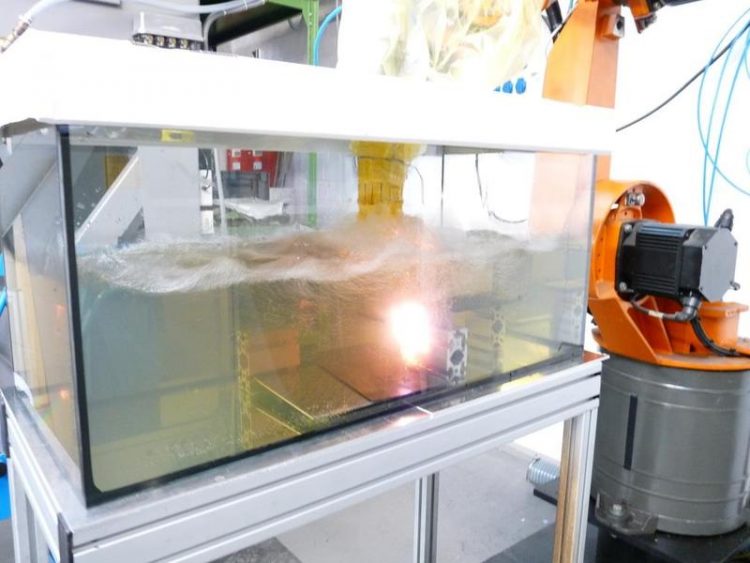Underwater laser cutting

Underwater laser cutting is a fast and thus economical alternative to conventional processes. Photo: LZH
For maintenance and repair of metal constructions, a number of processes are available, but these are time consuming and difficult on the divers.
For this reason, engineers at the Laser Zentrum Hannover e.V. (LZH) and the Leibniz Universität Hannover (LUH) are developing a process for automated, underwater laser cutting.
At the moment, mainly light arc oxygen cutting is being used for underwater cutting. The electrodes are hand-guided. Depending on the material thickness, divers need a workday to cut 20 meters in material. For a diving period of five hours this means a cutting speed of only 7 centimeter per minute.
Cutting seven times faster
With a laser-based automated process, the cutting speed should be increased by a factor of seven. “During pilot tests, we have already achieved a cutting speed of 0.5 meters per minute for 10 millimeter thick steel” says Dr.-Ing. Jörg Hermsdorf, head of the Machines and Controls Group at the LZH.
“With this process, underwater metal working could be considerably faster and thus less expensive. Our goal is to make the work of the divers safer and more efficient.”
Efficient dismantling of sheet piling
The process is being developed for dismantling sheet pilings in two to six meters deep water. For this, it is crucial that the pilings including the interlocks are reliably cut, as post processing is time-consuming and expensive. Since metal part corrode under water and are subject to overgrowth, the process is supposed to function reliably, even for varying material thicknesses and pollution levels.
The finished process could also be used for the maintenance and repair of offshore structures and other hydraulic structures. Also, dismantling of nuclear power plants is a further field of application.
The project “Laser cutting under water for higher productivity – LuWaPro” is supported by the German Federation of Industrial Research Associations “Otto von Guericke” e.V. (AiF).
http://www.lzh.de/de/publikationen/pressemitteilungen/2014/laserschneiden-unter-… – website with press realease and additional video
Media Contact
All latest news from the category: Process Engineering
This special field revolves around processes for modifying material properties (milling, cooling), composition (filtration, distillation) and type (oxidation, hydration).
Valuable information is available on a broad range of technologies including material separation, laser processes, measuring techniques and robot engineering in addition to testing methods and coating and materials analysis processes.
Newest articles

A universal framework for spatial biology
SpatialData is a freely accessible tool to unify and integrate data from different omics technologies accounting for spatial information, which can provide holistic insights into health and disease. Biological processes…

How complex biological processes arise
A $20 million grant from the U.S. National Science Foundation (NSF) will support the establishment and operation of the National Synthesis Center for Emergence in the Molecular and Cellular Sciences (NCEMS) at…

Airborne single-photon lidar system achieves high-resolution 3D imaging
Compact, low-power system opens doors for photon-efficient drone and satellite-based environmental monitoring and mapping. Researchers have developed a compact and lightweight single-photon airborne lidar system that can acquire high-resolution 3D…





















